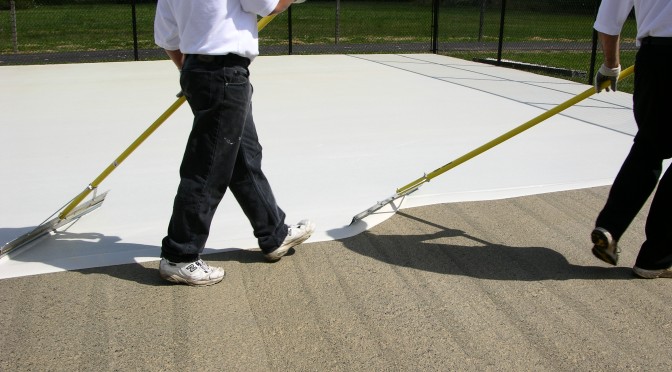Acrylic Resurfacer is a product that is commonly used when resurfacing tennis courts and other sport surfaces. All major manufacturers of acrylic sport surfaces produce this product and recommend using it on both new and existing court surfaces. Even though many installers think of Acrylic Resurfacer as a primer, it serves specific purposes not entirely related to good adhesion.
First of all, Acrylic Resurfacer is a filler coat. It is designed to suspend large amounts of silica sand for the purpose of filling minor voids in the surface. Asphalt is a common pavement used for tennis court construction. Mostly comprised of asphalt binder and rock, asphalt can exhibit a wide variety of porosity from one location to another. Many factors can influence the pavement porosity, from available regional and local sources of aggregate to project specifications. Acrylic Resurfacer can fill the surface voids to produce a tight surface without voids and pits that show through the pigmented surface layers. If the surface voids are not properly filled, they can lead to some of the following problems:
- Pitting on the playing surface
- Surface pinholes that are created from air in the voids during application of tennis court color coatings
- Poor coverage rate on the pigmented surface coatings
- Premature wear of the color coatings (surfaces)
When asphalt voids, or a heavy broom pattern on concrete, are not filled with the heavy sand load in resurfacer, it can leave high spots throughout the entire court surface. The high spots, top of the rock or broom pattern, are taking all of the wear and the coatings can wear and polish off the high points showing premature wear. So, not only is it important to use Acrylic Resurfacer, but it is also very important to use the manufacturer’s recommended size and amount of sand in the product. Applying resurfacer without the correct sand type and load can defeat the purpose of that step in the process.
Secondly, Acrylic Resurfacer creates or restores texture to the surface prior to application of the colored surface coatings. Existing acrylic sport surfaces tend to become smooth with years of wear. The fine silica sand that was in the coating eventually rolls out and the acrylic color surface becomes polished and smooth. The resurfacer uses an angular sand to create a sandpaper-like texture to better accept the color coating layers. The colored tennis court surfaces contain a very fine, rounded sand to minimize surface streaking and application marks. If resurfacer is not applied to create proper texture, the color coating can be applied too thin by the application squeegee. An example for comparison would be cleaning a glass window with a squeegee. Since the window is very smooth, the liquid glass cleaner is wiped almost completely off. If there is no texture on a tennis court, the surface coatings will not be applied in an adequate thickness. This will minimize film solids and shorten the life of the court surfacing system.
With its heavy body, one or more coats of Acrylic Resurfacer can also be used for shimming rough surface repairs, and hiding patches from depression or crack repairs. After application, resurfacer dries to a firm, hard film and can be scraped and sanded prior to application of the acrylic color surfacing coats.
Finally, the only situation where Acrylic Resurfacer is not required is when you have an existing acrylic surface with adequate texture. This occurs when the courts have been properly maintained and resurfaced before the original texture is lost. Visit SportMaster for a tennis court maintenance manual and for further care instructions on extending the life of the sport surfacing system.

